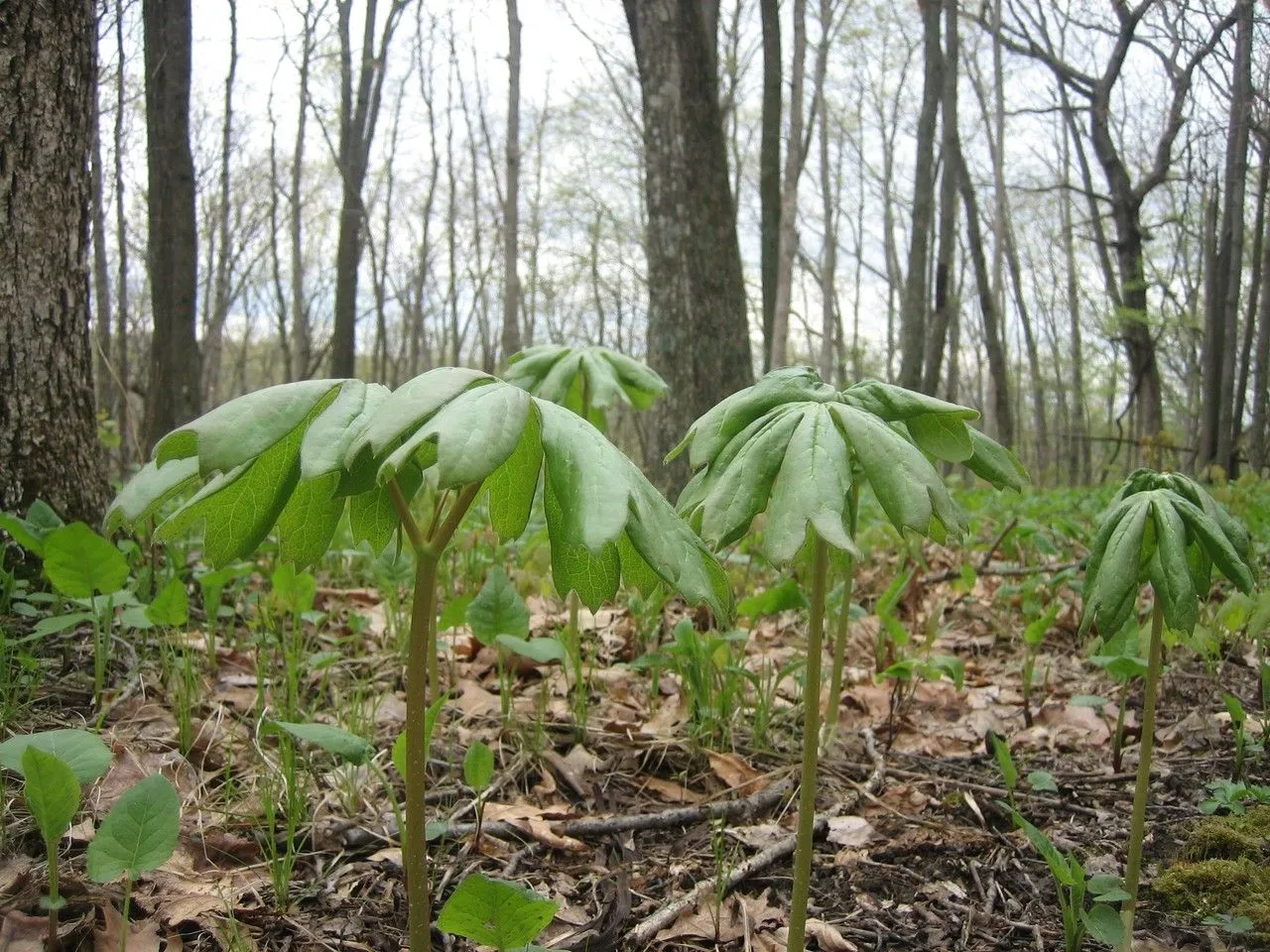
Author: L.
Bibliography: Sp. Pl.: 505 (1753)
Year: 1753
Status: accepted
Rank: species
Genus: Podophyllum
Vegetable: False
Observations: SE. Canada to C. & E. U.S.A.
The Mayapple, scientifically known as Podophyllum peltatum, is a perennial herbaceous plant endemic to regions extending from southeastern Canada to central and eastern United States. Initially documented in 1753 by Linnaeus in his seminal work “Species Plantarum,” this intriguing plant has captivated botanists and herbalists alike for centuries.
Belonging to the Berberidaceae family, the Mayapple thrives in deciduous forests and shady areas. It is notable for its unique growth pattern, often emerging early in the spring with umbrella-like leaves that can overshadow and dominate the forest understory. The leaves are typically large, lobed, and can range from a vibrant green to a darker hue as they mature.
One of the most remarkable features of the Mayapple is its solitary, white, and sometimes fragrant flower, which typically blooms in the late spring. This flower later gives way to a pale green to yellowish fruit resembling a small apple, hence the common name. However, it is crucial to note that while the ripe fruit is considered edible and has been used in traditional remedies, other parts of the plant are highly toxic and can cause severe reactions if ingested.
In ethnobotany, extracts from Podophyllum peltatum have been utilized for their medicinal properties, particularly as a purgative and for their antiviral and anti-tumor activities. Modern medicine has harnessed compounds derived from the Mayapple, such as podophyllotoxin, which is pivotal in producing drugs for treating various cancers and viral infections.
Despite its beneficial uses, the Mayapple should be approached with caution due to its potent toxicity. Conservation efforts and responsible harvesting are essential to ensure this plant continues to thrive in its natural habitat, preserving its ecological role and potential future contributions to medicine.
In sum, the Mayapple stands as a fascinating example of nature’s dual capacity for danger and healing, richly embodying the complex interplay between plant life and its environmental and medicinal contexts.
Eng: american-mandrake, indian-apple, may apple, mayapple, pomme de mai, wild mandrake, wild-mandrake, may-apple
Deu: entenfuß, nordamerikanischer maiapfel, gewöhnlicher maiapfel
Swe: amerikanskt fotblad
Fra: podophylle pelté, pomme de mai
En: Mayapple, American-mandrake, Wild mandrake, May-Apple, Indian-apple, May apple, Pomme de mai, Wild-mandrake
Ar: تفاح مايو
Az: Qalxanabənzər podofil
Bg: Щитовиден подофил
Ca: Podofil
Cs: Noholist štítnatý
Da: Prærie-Fodblad
Fi: Amerikanjalkalehti
Fr: Pomme de mai, Podophylle pelté
De: Entenfuß, Gewöhnlicher Maiapfel, Schildförmiges Fußblatt, Nordamerikanischer Maiapfel
Ne: लघुपत्र
Pl: Stopkowiec tarczowaty
Ru: Podofill ščitovidnyj, Podofill amerikanskij, Подофилл щитовидный
Sv: Amerikanskt fotblad
Tl: Podopil
Taken May 16, 2021 by Joe W (cc-by-sa)
Taken May 19, 2019 by jean-michel henna (cc-by-sa)
Taken Apr 30, 2020 by John Ear (cc-by-sa)
Taken Apr 13, 2016 by EOL − kara_oliver (cc-by-nc)
Taken May 3, 2019 by Wilhelm Rogmann (cc-by-sa)
Taken Apr 30, 2021 by Matthias Foellmer (cc-by-sa)
Taken May 26, 2021 by Peter Smith (cc-by-sa)
Taken May 5, 2021 by karen engell (cc-by-sa)
Taken Apr 1, 2020 by Jennifer (cc-by-sa)
Taken May 4, 2022 by warren Swans (cc-by-sa)
Taken Apr 12, 2016 by EOL − cwwood (cc-by-sa)
Taken Apr 12, 2016 by EOL − Erik Attaway (cc-by-nc)
Taken May 9, 2020 by Lily Jones (cc-by-sa)
Taken May 3, 2019 by Wilhelm Rogmann (cc-by-sa)
Taken May 9, 2009 by EOL − aposematic herpetologist (cc-by-nc)
Taken Jul 16, 2022 by Phillip Jindra (cc-by-sa)
Taken May 22, 2019 by Nancy Schiano (cc-by-sa)
Taken May 16, 2021 by Jeanne (cc-by-sa)
Taken May 22, 2019 by Nancy Schiano (cc-by-sa)
Taken Jul 18, 2021 by Eustace Taylor (cc-by-sa)
Taken May 21, 2020 by Joshua Griffin (cc-by-sa)
Taken Apr 26, 2021 by Christina Emery (cc-by-sa)
Taken Jun 1, 2021 by Wolf2Gaming (cc-by-sa)
Taken Apr 24, 2019 by Mike Williams (cc-by-sa)
Taken May 3, 2020 by Hech Zios (cc-by-sa)
Taken Apr 21, 2015 by EOL − gretchkin (cc-by-nc)
Taken May 2, 2013 by EOL − Haley (cc-by-nc)
Taken Jan 1, 1900 by EOL − Nicholas A. Tonelli from Pennsylvania, USA (cc-by)
Taken May 6, 2014 by EOL − Evan Raskin (cc-by-nc)
Taken May 9, 2020 by Lily Jones (cc-by-sa)
© copyright of the Board of Trustees of the Royal Botanic Gardens, Kew.
Growth habit: Forb/herb
Family: Myrtaceae Author: (F.Muell.) K.D.Hill & L.A.S.Johnson Bibliography: Telopea 6: 402 (1995) Year: 1995 Status:…
Family: Rubiaceae Author: Pierre ex A.Froehner Bibliography: Notizbl. Bot. Gart. Berlin-Dahlem 1: 237 (1897) Year:…
Family: Sapindaceae Author: Koidz. Bibliography: J. Coll. Sci. Imp. Univ. Tokyo 32(1): 38 (1911) Year:…
Family: Asteraceae Author: A.Gray Bibliography: Pacif. Railr. Rep.: 107 (1857) Year: 1857 Status: accepted Rank:…
Family: Fabaceae Author: Medik. Bibliography: Vorles. Churpfälz. Phys.-Ökon. Ges. 2: 398 (1787) Year: 1787 Status:…
Family: Aspleniaceae Author: (Cav.) Alston Bibliography: Bull. Misc. Inform. Kew 1932: 309 (1932) Year: 1932…